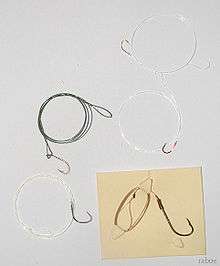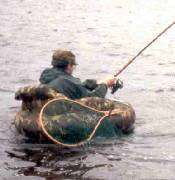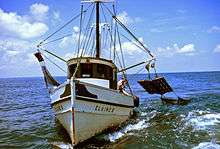Fishing line
A fishing line is a cord used or made for angling. Fishing line is generally as durable as and comparable to a string. Important parameters of a fishing line are its length, material, and weight (thicker lines are more visible to fish). Factors that may determine what line an angler chooses for a given fishing environment include breaking strength, knot strength, UV resistance, castability, limpness, stretch, abrasion resistance, and visibility. Most modern lines are made from nylon, braided polymers, or silk.[1][2]

Terminology
Fish are caught with a fishing line by encouraging a fish to bite on a fish hook. A fish hook will pierce the mouthparts of a fish and is normally barbed to make escape less likely. Another method is to use a gorge, which is buried in the bait such that it would be swallowed end first. The tightening of the line would fix it cross-wise in the quarry's stomach or gullet and so the capture would be assured.
Fishing with a hook and line is called angling. In addition to the use of the hook and line used to catch a fish, a heavy fish may be landed by using a landing net or a hooked pole called a gaff.
Trolling is a technique in which a fishing lure on a line is drawn through the water. Trolling from a moving boat is a technique of big-game fishing and is used to catch large open-water species such as tuna and marlin. Trolling is also a freshwater angling technique often used to catch salmon, northern pike, muskellunge and walleye. This technique allows anglers to cover a large body of water in a short time.
Long-line fishing, also known as a trot line is a commercial fishing technique that uses many baited hooks hanging from a single line.
Snagging is a technique where the object is to hook the fish in the body. Generally, a large treble hook with a heavy sinker is cast into a river containing a large amount of fish, such as a Salmon, and is quickly jerked and reeled in. Due to the often illegal nature of this method some practitioners have added methods to disguise the practice, such as adding bait or piercing the jerking motion.
Early lines
Leonard Mascall, in his book from 1596 titled “A Booke of fishing with Hooke and Line, and of all other instruments thereunto belonging.” followed in many ways after Dame Juliana Berners, has an excerpt establishing silk worms in the area of England at that time:
... “In May, take the stone flye or Caddis worme, and the bobbe worme vnder the Cowtorde: also ye may take the silke worme, and the baite that breedeth on a Fearne leafe.” ...
And another excerpt explaining compiling a silk leader-line for a catgut fly-line.
...whippe it so faire as yee shall see good, then next your hooke at the bought put throw your silke or haire in going round about the hooke three times, then plucke first your silke or haire...
So back then there was silk and horse hair used for angling.
As written in 1667 by Samuel Pepys, the fishing lines in his time were made from catgut.[3] Later, silk fishing lines were used around 1724.[4]
Modern lines
Modern fishing lines intended for spinning, spin cast, or bait casting reels are almost entirely made from artificial substances, including nylon, polyvinylidene fluoride (PVDF, also called fluorocarbon), polyethylene, Dacron and UHMWPE (Honeywell's Spectra or Dyneema). The most common type is monofilament, made of a single strand. Fishermen often use monofilament because of its buoyant characteristics and its ability to stretch under load. The line stretch has advantages, such as dampening the force when setting the hook and when fighting strong fish. On very far distances the dampening may become a disadvantage. Recently, other alternatives to standard nylon monofilament lines have been introduced made of copolymers or fluorocarbon, or a combination of the two materials. Fluorocarbon fishing line is made of the fluoropolymer PVDF and it is valued for its refractive index, which is similar to that of water, making it less visible to fish. Fluorocarbon is also a denser material, and therefore, is not nearly as buoyant as monofilament. Anglers often utilize fluorocarbon when they need their baits to stay closer to the bottom without the use of heavy sinkers. There are also braided fishing lines, cofilament and thermally fused lines, also known as 'superlines' for their small diameter, lack of stretch, and great strength relative to standard nylon monofilament lines. Braided, thermally fused, and chemically fused varieties of 'superlines' are now readily available.
Specialty lines
Fly lines consist of a tough braided or monofilament core, wrapped in a thick waterproof plastic sheath, often of polyvinyl chloride (PVC). In the case of floating fly lines, the PVC sheath is usually embedded with many 'microballoons' or air bubbles, and may also be impregnated with silicone or other lubricants to give buoyancy and reduce wear. In order to fill up the reel spool and ensure an adequate reserve in case of a run by a powerful fish, fly lines are usually attached to a secondary line at the butt section, called backing. Fly line backing is usually composed of braided dacron or gelspun monofilaments. All fly lines are equipped with a leader of monofilament or fluorocarbon fishing line, usually (but not always) tapered in diameter, and referred to by the 'X-size' (0X, 2X, 4X, etc.) of its final tip section, or tippet. Tippet size is usually between 0X and 8X, where 0X is the thickest diameter and 8X is the thinnest. There are exceptions to this, and tippet sizes do exist outside of the 0X-8X parameter.[5]
Tenkara lines are special lines used for the fixed-line fishing method of tenkara. Traditionally these are furled lines the same length as the tenkara rod. Although original to Japan, these lines are similar to the British tradition of furled leader. They consist of several strands being twisted together in decreasing numbers toward the tip of the line, thus creating a taper that allows the line to cast the fly. It serves the same purpose as the fly-line, to propel a fly forward. They may be tied of various materials, but most commonly are made of monofilament.
Wire lines are frequently used as leaders to prevent the fishing line from being severed by toothy fish. Usually braided from several metal strands, wire lines may be made of stainless steel, titanium, or a combination of metal alloys coated with plastic.
Stainless steel line leaders provide:
- bite protection - it is extremely hard for fish to cut the steel wire, regardless of jaw and teeth strength and sharpness,
- abrasion resistance - sharp rocks and objects can damage other lines, while steel wire can cut through most of the materials,
- single wire (single strand) leaders are not as flexible as multi strand steel wire, but are extremely strong and tough,
- multi strand steel wire leaders are very flexible, but are somewhat more abrasive and more damage prone than single strand wires.
Titanium fishing fishing leaders are actually titanium-nickel alloys that have several very important features:
- titanium leader lines are very flexible, regardless if they are single or multi strand lines/wires,
- these lines are very elastic - they can stretch up to 10% without permanent damage to the line itself - perfect for hook setting,
- these lines are knottable just as nylon monofilament lines,
- surface is rather hard and abrasion resistant - great for fishing toothy fish,
- titanium wire is corrosion resistant and can last for a long time, even surpassing stainless steel wires,
- due to the strength and elasticity, titanium wires are almost entirely kink-proof.
Copper, monel and lead core fishing lines are used as heavy trolling main lines, usually followed with fluorocarbon line near the lure or bait with fishing swivel between the lines. Due to their high density, these fishing lines sink rapidly in water and they require less line for achieving desired trolling depth. On the other hand, these lines are relatively thick for desired strength, especially when compared with braided fishing lines and they often require reels with larger spools.
Environmental impact
Discarded monofilament fishing line takes up to 600 years to decompose.[6] There have been several types of biodegradable fishing lines developed to minimize the impact on the environment.[7][8][9][10]
See also
- Ultra high molecular weight polyethylene
- Braided fishing line
- Fishing
- Fish hook
- Fluorocarbon
- Fly fishing
- Monofilament line
- Multifilament fishing line
References
- The World Book Encyclopedia Volume 7. Field Enterprises Educational Corp. 1968.
- McNally, Bob (August 2, 2019), How to Pick the Right Kind of Fishing Line, Outdoor World
- The World Book Encyclopedia Volume 7. Field Enterprises Educational Corp. 1968.
- The World Book Encyclopedia Volume 7. Field Enterprises Educational Corp. 1968.
- Carter Reschke, "What Tippet Size to Use", Fly Fever Magazine, October 24, 2018
- "Approximate Time it Takes for Garbage to Decompose in the Environment" (PDF). NH Department of Environmental Services. Archived from the original (PDF) on 24 December 2018. Retrieved 31 March 2018.
- Merwin: Does Bioline (Biodegradeable Fishing Line) Measure Up? September 30, 2009 Field and StreamRetrieved March 15, 2017
- New Fishing Line Safer for Environment Archived 2018-12-01 at the Wayback Machine The Daily Comet Retrieved March 15, 2017
- fishing line kicks goals in Australia sea breeze.com.au
- Bird, Levi Environmentally-Friendly Biodegradable Fishing Line chum-bucket.com Retrieved March 15, 2017

